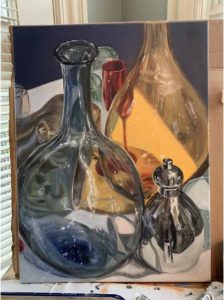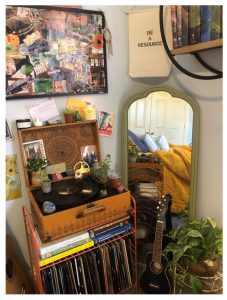
In March, when UA had to impose social distancing to protect students, faculty and staff from the coronavirus, changes to teaching methods and learning experiences across campus were often abrupt and even disorienting. When teaching involved hands-on demonstrations or in-class practice, as it does in art and art history, painters, ceramicists, printmakers, as well as art historians and gallery directors, struggled to make their subjects real and relevant to their suddenly distanced students. Below, a few of the department’s faculty and staff talk about how they coped with the changes and came out stronger.
GroupMe App Connects Painters
As Professor Jason Guynes asked himself, “How do you continue to teach painting, have group critiques, and support each other while your class is dispersed across the country?” Guynes kept his class in touch with each other by using a group text messaging phone app, GroupMe, that allowed everyone to chat during his Painting I class meetings. Students stayed in touch, posted in-progress and final images of their works, and offered each other constructive criticism and words of encouragement via the app. Guynes said that a painting class is a close community, and that many students commented that using this process helped them to still feel connected to their classmates during the most difficult parts of the lockdown period.
Quiet Potter’s Wheels

When the campus was abruptly cleared of students, it interrupted student projects from sculpting to curating an exhibit. Assistant Professor Wade MacDonald had to shift his upper-level ceramics students from creating hands-on clay projects to learning different but related techniques and skills online. MacDonald had them complete an in-depth online glaze chemistry course, use the software Rhinoceros to design and model future clay projects digitally, research and hand in recorded presentations on topics in ceramics, and create a collection of ready-made artworks in the manner of the 1960s and ‘70s Fluxus art movement.
MacDonald said that he can sense that his students miss the connection they felt in their studio classes and are eager to be back in working with real clay. “The camaraderie between students, and the overall communal atmosphere of the studio space promotes and encourages their involvement in the ceramics process.”
Empty Galleries
“The hardest part for us was the sudden silence and locking the doors to the public,” said Daniel White, director of the Paul R. Jones Museum and The University of Alabama Gallery. “The group of student workers that I count on to help staff the galleries really bring these spaces to life with their joyful energy.” In early March, the Jones Museum had just opened It’s Like That: Selections from the Collection of Rebecca and Jack Drake and had to cancel the reception. This was the “big one,” White said, “the kind of show that doesn’t come around very often, but we created a ‘virtual tour’ of the show and posted the video to social media and the website so people could continue to enjoy it, even from a distance.”
White said both the museum and gallery are moving toward having more exhibits online. “We are exploring how to connect digitally in ways that we have not before. We did a talk with the collectors group at AIEVA via Zoom for It’s Like That, and that was fulfilling to connect more with our friends at UAB.”
“The big takeaway for me,” White added, “has been the value of engagement, really just spending time with others, whether it’s our colleagues, friends or family. You cannot permanently replace that kind of connection with a digital screen.”
For more information about The University of Alabama’s programs in art history and studio art, visit our Degree Programs page.



